Design and Visual Culture from the Bauhaus to Contemporary Arts
This book complements the more textually based Bauhaus scholarship with a practice-oriented and creative interpretive method, which makes it possible to consider Bauhaus-related works in an unconventional light. Edit Toth argues that focusing on the functionalist approach of the Bauhaus has hindered scholars from properly understanding its design work. With a global scope and under-studied topics, the book advances current scholarly discussions concerning the relationship between image technologies and the body by calling attention to the materiality of image production and strategies of re-channeling image culture into material processes and physical body space, the space of dimensionality, and everyday activity.
Edit Tth is a lecturer at Pennsylvania State University, Altoona.
Cover Image: Lszl Moholy-Nagy, Traffic (City Lights: Estgate Hotel, Chicago), 193746. Courtesy of Hattula Moholy-Nagy
Routledge Advances in Art and Visual Studies
This series is our home for innovative research in the fields of art and visual studies. It includes monographs and targeted edited collections that provide new insights into visual culture and art practice, theory, and research.
For a full list of titles in this series, please visit www.routledge.com/Routledge-Advances-in-Art-and-Visual-Studies/book-series/RAVS
Perception and Agency in Shared Spaces of Contemporary Art
Edited by Cristina Albu and Dawna Schuld
Contemporary British Ceramics and the Influence of Sculpture
Iconoclasm, Monument, and Multiples
Laura Gray
Contemporary Citizenship, Art, and Visual Culture
Making and Being Made
Edited by Corey Dzenko and Theresa Avila
The Evolution of the Image
Political Action and the Digital Self
Edited by Marco Bohr and Basia Sliwinska
Artistic Visions of the Anthropocene North
Edited by Gry Hedin and Ann-Sofie N. Gremaud
Contemporary Artists Working Outside the City
Creative Retreat
Sarah Lowndes
Design and Visual Culture from the Bauhaus to Contemporary Art
Optical Deconstructions
Edit Tth
Changing Representations of Nature and the City
The 1960s1970s and Their Legacies
Edited by Gabriel Gee and Alison Vogelaar
Design and Visual Culture from the Bauhaus to Contemporary Art
Optical Deconstructions
Edit Tth

First published 2018
by Routledge
711 Third Avenue, New York, NY 10017
and by Routledge
2 Park Square, Milton Park, Abingdon, Oxon OX14 4RN
Routledge is an imprint of the Taylor & Francis Group, an informa business
2018 Taylor & Francis
A shorter version of Chapter 2 was published as Breuers Furniture, Moholy-Nagys Photographic Paradigm and Complex Gender Expressivity at the Haus am Horn, Grey Room 50 (Winter 2013): 90111. An earlier version of Chapter 3 was published as Capturing Modernity: Jazz, Film and Moholy-Nagys Light Prop for an Electric Stage, Modernism/modernity 22, no. 1 (January 2015): 2355.
The right of Edit Tth to be identified as author of this work has been asserted by him/her in accordance with sections 77 and 78 of the Copyright, Designs and Patents Act 1988.
All rights reserved. No part of this book may be reprinted or reproduced or utilised in any form or by any electronic, mechanical, or other means, now known or hereafter invented, including photocopying and recording, or in any information storage or retrieval system, without permission in writing from the publishers.
Trademark notice: Product or corporate names may be trademarks or registered trademarks, and are used only for identification and explanation without intent to infringe.
Library of Congress Cataloging in Publication Data
A catalog record for this book has been requested
ISBN: 978-1-138-48061-2 (hbk)
ISBN: 978-1-351-06246-6 (ebk)
Typeset in Sabon
by Out of House Publishing
Dedicated to the memory of my father
Contents
and his comments on Japanese architecture. Invitations from various institutions to present my ideas related to the book helped organize my thoughts, including the National Gallery in Washington D.C., the Philadelphia Museum of Art, the University of Cincinnati, the Columbus College of Arts and Design, and Pennsylvania State University at University Park and Altoona. I thank the anonymous readers and editors at Modernism/modernity, Grey Room, Oxford Art Journal, and Routledge for their helpful advice, and va Bajkay at the Hungarian National Gallery. For the imaginative debates when formulating the book, I thank Jason Benton.
Arguably, the Bauhaus was the first internationally acknowledged institution that formulated a coherent attitude towards modern design and its relation to the emerging image culture. Do its concerns still have relevance for us in our twentieth-first-century world of seemingly endless supply of consumer products and image flow? The answer is not really if we content ourselves with the rigid view of Bauhaus design promulgated by postmodernism (to some extent based on the schools own rhetoric), which exhausts itself in an obstinate pursuit of rationalism and functionalism, and a naive social utopia. Based on this understanding of the institution, contemporary Can we critically understand Bauhaus designs complex relation to visual culture and ask what its ongoing critical legacies may be? To recognize its import, it would be profitable to think of design in a broad sense, and as a practice rather than a product, as a practice still embracing multiple meanings, as it was thought of right before its final separation from artistic and handcraft practices.
Although photography became part of the Bauhaus curriculum only in 1929, after Lszl Moholy-Nagy left the school, students enthusiastically experimented with its various techniques inspired by his and other leading artists photograms, photomontages, New Vison pictures, and typo-photos (combination of photography and typography) from about 1925. While not made for a Bauhaus publication, Moholy-Nagys cover for the 1931 first issue of the magazine Foto-Qualitt () carried out after he left the Bauhaus helps illuminate an important aspect not merely of Bauhaus advertising or graphic design but of Bauhaus design in general. Instead of matching the photographic camera with the eye, as in Dziga Vertovs famous camera eye, for instance, the artist juxtaposed it with the hand, highlighting its function as a hand tool. The picture insists that the camera is more than a mechanical eye; it helps to transform and question the world around us. Nevertheless, the camera that carries out the transformation in the picture is not one of the latest models. Rather, it appears to be an early camera, which operates with a visibly and manually assembled glass plate, mirror, lens, and framing aperture. The process of creating an image with it requires technical skill and hand manipulation, not unlike playing on the strings of a guitar or constructing an object. As the back cover suggests, with proper maneuvering and experimentation, its mechanism may open up new vistas, vortex-like spaces of possibilities, and latent meanings inherent in our surroundings, overcoming its inbuilt one-point perspective view and challenging our automatic acceptance of its conventional rationalized framework.















